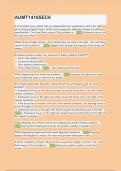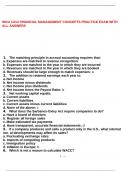-
1. Exam (elaborations) - Steering & suspension systems questions with 100% correct answers verified latest upd...
-
2. Exam (elaborations) - Steering & suspension intro questions with 100% correct answers verified latest updat...
-
3. Exam (elaborations) - Automotive steering & suspension (ase) 23 24 42-06 questions with 100% correct answer...
-
4. Exam (elaborations) - Steering, suspension and wheel alignment questions with 100% correct answers verified...
-
5. Exam (elaborations) - Steering and suspension questions with 100% correct answers verified latest update 20...
-
6. Exam (elaborations) - Chapter 1 suspension & steering questions with 100% correct answers verified latest u...
-
7. Exam (elaborations) - Steering and suspension final-- questions with 100% correct answers verified latest u...
-
8. Exam (elaborations) - Suspension & steering sos test questions with 100% correct answers verified latest up...
-
9. Exam (elaborations) - Steering and suspension test questions with 100% correct answers verified latest upda...
-
10. Exam (elaborations) - Steering and suspension - questions with 100% correct answers verified latest update ...
-
11. Exam (elaborations) - Suspension and steering 5 questions with 100% correct answers verified latest update ...
-
12. Exam (elaborations) - Suspension and steering vocabulary questions with 100% correct answers verified lates...
-
13. Exam (elaborations) - Suspension and steering linkage systems questions with 100% correct answers verified ...
-
14. Exam (elaborations) - Ase g1 d. suspension and steering questions with 100% correct answers verified latest...
-
15. Exam (elaborations) - Steering and suspension test - questions with 100% correct answers verified latest up...
-
16. Exam (elaborations) - Ase_ steering and suspension questions with 100% correct answers verified latest upda...
-
17. Exam (elaborations) - Automotive suspension and steering questions with 100% correct answers verified lates...
-
18. Exam (elaborations) - Suspension, steering, brakes-- questions with 100% correct answers verified latest up...
-
19. Exam (elaborations) - Chapter 18-steering and suspension questions with 100% correct answers verified lates...
-
20. Exam (elaborations) - Auto steering and suspension questions with 100% correct answers verified latest upda...
-
21. Exam (elaborations) - Intro to auto steering and suspension questions with 100% correct answers verified la...
-
22. Exam (elaborations) - Steering and suspension - questions with 100% correct answers verified latest update ...
-
23. Exam (elaborations) - Steering and suspension -- questions with 100% correct answers verified latest update...
-
24. Exam (elaborations) - Steering and suspension ase questions with 100% correct answers verified latest updat...
-
25. Exam (elaborations) - Steering and suspension vocab questions with 100% correct answers verified latest upd...
-
26. Exam (elaborations) - Suspension, steering, and tires questions with 100% correct answers verified latest u...
-
27. Exam (elaborations) - Steering and suspension test 4 questions with 100% correct answers verified latest up...
-
28. Exam (elaborations) - Chapter 18-steering and suspension questions with 100% correct answers verified lates...
-
29. Exam (elaborations) - Steering and suspension dsa questions with 100% correct answers verified latest updat...
-
30. Exam (elaborations) - 7 suspension and steering technology questions with 100% correct answers verified lat...
-
31. Exam (elaborations) - Steering and suspension test 1 (ch 1,3,4,5) - questions with 100% correct answers ver...
-
32. Exam (elaborations) - Ase a4- steering and suspension -- questions with 100% correct answers verified lates...
-
33. Exam (elaborations) - Steering and suspension final questions with 100% correct answers verified latest upd...
-
34. Exam (elaborations) - Suspension and steering ase final questions with 100% correct answers verified latest...
-
35. Exam (elaborations) - Amt113-04 steering and suspension final questions with 100% correct answers verified ...
-
36. Exam (elaborations) - Steering and suspension -- questions with 100% correct answers verified latest update...
-
37. Exam (elaborations) - Steering and suspension exam 2 ccp questions with 100% correct answers verified lates...
-
38. Exam (elaborations) - Automotive maintenance suspension, steering, and tires - questions with 100% correct ...
-
39. Exam (elaborations) - Steering and suspension ase prep questions with 100% correct answers verified latest ...
-
40. Exam (elaborations) - Suspension and steering questions with 100% correct answers verified latest update 20...
-
41. Exam (elaborations) - Ase a6 automotive electrical & electronic systems questions with 100% correct answers...
-
42. Exam (elaborations) - Suspension and steering practice test questions with 100% correct answers verified la...
-
43. Exam (elaborations) - T5 suspension and steering questions with 100% correct answers verified latest update...
-
44. Exam (elaborations) - Aumt1416sec6 questions with 100% correct answers verified latest update 2024
-
45. Exam (elaborations) - Suspension & steering a4 copy unit 5 questions with 100% correct answers verified lat...
-
46. Exam (elaborations) - Steering and suspension questions with 100% correct answers verified latest update 20...
-
47. Exam (elaborations) - Automotive maintenance suspension, steering, and tires - questions with 100% correct ...
-
48. Exam (elaborations) - Ase a4 steering and suspension questions with 100% correct answers verified latest up...
-
49. Exam (elaborations) - Ase steering and suspension- questions with 100% correct answers verified latest upda...
-
50. Exam (elaborations) - Final exam - suspension and steering questions with 100% correct answers verified lat...
-
51. Exam (elaborations) - Auto 1 steering and suspension questions with 100% correct answers verified latest up...
-
52. Exam (elaborations) - Assessment b questions with verified correct answers
-
53. Exam (elaborations) - Ase t5 suspension & steering practice test #1 questions with 100% correct answers ver...
-
Show more





